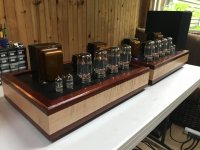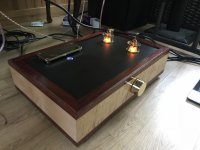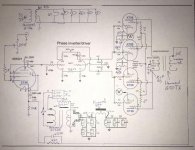Excellent news. Well done.
Alan
''I would have never chosen this design''. Well it was a guitar amp design after all.
Alan
''I would have never chosen this design''. Well it was a guitar amp design after all.
Great to hear that this is now a well working amp, and it is going to work for enjoying music!
I hope we all learned something along the way.
I hope we all learned something along the way.
All done! Need to get a decent AV rack now.
This thread will be a good compilation of ideas for noise reduction and troubleshooting .
Thanks again
This thread will be a good compilation of ideas for noise reduction and troubleshooting .
Thanks again
Attachments
Last edited:
Always good to know that a crap diode can manifest like this. I've never used a 1N4007 for tube power, for 60Hz I go with 6A10 because I don't limit inrush...
Always good to know that a crap diode can manifest like this. I've never used a 1N4007 for tube power, for 60Hz I go with 6A10 because I don't limit inrush...
Anything that is out of specs can screw things up.
Hello all,
i’m looking to reduce the gain if possible in a pair of mono blocks I have recently built. Some of you might remember helping me with the mechanical buzz issues that I was having about a week ago. Now they sound very nice and are perfectly usable but the gain is still very high with this design.
I’ve been doing some research, and just want to hear some peoples thoughts about how to reduce gain in these amps. One thought I had was to bypass the first stage entirely (EF 86) and feed the signal from the preamp into the inverter.
Being relatively new and still learning, i’m not sure if it’s as simple as feeding best signal directly into the inverter or what other changes would have to be made to do so
There may even be better ways to reduce the gain.
Let me know if it’s doable.
Thanks guys
i’m looking to reduce the gain if possible in a pair of mono blocks I have recently built. Some of you might remember helping me with the mechanical buzz issues that I was having about a week ago. Now they sound very nice and are perfectly usable but the gain is still very high with this design.
I’ve been doing some research, and just want to hear some peoples thoughts about how to reduce gain in these amps. One thought I had was to bypass the first stage entirely (EF 86) and feed the signal from the preamp into the inverter.
Being relatively new and still learning, i’m not sure if it’s as simple as feeding best signal directly into the inverter or what other changes would have to be made to do so
There may even be better ways to reduce the gain.
Let me know if it’s doable.
Thanks guys
Attachments
Increasing the gNFB will lower the gain (try 10k or 4k7 and adjust the 470pf cap to suit), as will a simple voltage divider between the EF86 and the 12AT7 (replace the 470k with two 220k in series, and take the signal from the middle of the two). You can try removing the EF86 and inserting the signal directly into the 12AT7 but you might decrease the gain too much.
Last edited:
 @Diyengineer - please do not start multiple threads for the same project, your threads have been merged.
@Diyengineer - please do not start multiple threads for the same project, your threads have been merged.Increasing the global negative feed back can lower the amplifier gain. But it could also cause the amplifier to be unstable. Lower the internal amplifier gain before increasing the global negative feedback.
Completely taking out the first stage (triode wired EF86) that has an open loop stage gain a little less than 40, could be a problem. It is the path for the global negative feedback. You need some kind of input stage, to be able to use global negative feedback.
Changing circuits that use global negative feedback can be tricky. But here are three things to try, and see if they work for you.
You could change the input stage to a lower gain ECC82 / 12AU7 input stage (gain a little less than 20). You should be able to re-adjust the feedback network, and still be stable. Increase the negative feedback by 6 dB. Start with 11k and 940pF. That would reduce the amplifier gain by about 6 dB. You should still have about the same maximum output power.
Or . . . you could keep the EF86 just the way you have it, but change the output stage to triode wired KT66 tubes. With triode wiring, the KT66 gain drops a lot, which means you should be able to increase the global negative feedback, and still be stable. Increase the negative feedback (i.e. 11k / 940 pF). That would reduce the amplifier gain by about 6 dB. But this method will also decrease the maximum output power, versus pentode mode.
With triode wired KT66, you could disconnect the global negative feedback. The triode wiring may drop the gain enough by itself (or triode wire the KT66s, and also replace the EF86 with an ECC82). The gain will go down. This will likely change the sound of the amplifier more versus all the topologies that use global negative feedback. Again, you will decrease the maximum output power versus pentode mode.
You may choose to try all these methods, and see which one you prefer the sound of.
Have fun, and enjoy listening!
Completely taking out the first stage (triode wired EF86) that has an open loop stage gain a little less than 40, could be a problem. It is the path for the global negative feedback. You need some kind of input stage, to be able to use global negative feedback.
Changing circuits that use global negative feedback can be tricky. But here are three things to try, and see if they work for you.
You could change the input stage to a lower gain ECC82 / 12AU7 input stage (gain a little less than 20). You should be able to re-adjust the feedback network, and still be stable. Increase the negative feedback by 6 dB. Start with 11k and 940pF. That would reduce the amplifier gain by about 6 dB. You should still have about the same maximum output power.
Or . . . you could keep the EF86 just the way you have it, but change the output stage to triode wired KT66 tubes. With triode wiring, the KT66 gain drops a lot, which means you should be able to increase the global negative feedback, and still be stable. Increase the negative feedback (i.e. 11k / 940 pF). That would reduce the amplifier gain by about 6 dB. But this method will also decrease the maximum output power, versus pentode mode.
With triode wired KT66, you could disconnect the global negative feedback. The triode wiring may drop the gain enough by itself (or triode wire the KT66s, and also replace the EF86 with an ECC82). The gain will go down. This will likely change the sound of the amplifier more versus all the topologies that use global negative feedback. Again, you will decrease the maximum output power versus pentode mode.
You may choose to try all these methods, and see which one you prefer the sound of.
Have fun, and enjoy listening!
Last edited:
Thanks,
Forgot to mention, if I increase the NFB as the amp is now, it starts to oscillate.
To try triode mode, I believe I would disconnect the screen grids and attach to the plates with a 100R resistor or so, correct?
Thanks
Forgot to mention, if I increase the NFB as the amp is now, it starts to oscillate.
To try triode mode, I believe I would disconnect the screen grids and attach to the plates with a 100R resistor or so, correct?
Thanks
kward,
If you only remove the 1000uF cap from the EF86 triode, it will do two things:
1. Reduce the EF86 gain
2. Reduce the global negative feedback.
The problem is that with reduced global negative feedback, the total amplifier gain will go Up, it will not go down.
If you only remove the 1000uF cap from the EF86 triode, it will do two things:
1. Reduce the EF86 gain
2. Reduce the global negative feedback.
The problem is that with reduced global negative feedback, the total amplifier gain will go Up, it will not go down.
Triode mode, yes just that.
- Then what about trying the KT66s in triode mode? You would need four 100 ohm 1 or 2 watt resistors. Take the screen grid feeds off pins 4 and insulate them. Now solder a 100 resistor from pin 4 back to pin 3, the anode/plate.
Triode mode!
Alan
Don't forget, triode wiring the KT66s will reduce their Internal gain.
But with the global negative feedback values the same, the total amplifier gain will remain the same (you have excess gain in the input plus inverter stages versus the gain you want, so global negative feedback still dictates the total amplifier gain)
You would need to increase the negative feedback (lower R and larger C).
The next trial could be Triode wiring, Plus changing the input stage to a 12AU7, plus removing the negative feedback. That will decrease the total amplifier gain; and with triode wiring the KT66s you may not need global feedback at all.
You could also try triode wiring the KT66s, remove the 1000uF capacitor from the EF86, And remove the global negative feedback (easy to wire and try).
But you might also have to change the EF86 plate resistor (try changing from 68 k to 33k to get the gain down).
You and Alan were right . . . remove the screens from the B+, and use four 100 Ohm resistors, one per tube from pins 4 to pin 3.
But with the global negative feedback values the same, the total amplifier gain will remain the same (you have excess gain in the input plus inverter stages versus the gain you want, so global negative feedback still dictates the total amplifier gain)
You would need to increase the negative feedback (lower R and larger C).
The next trial could be Triode wiring, Plus changing the input stage to a 12AU7, plus removing the negative feedback. That will decrease the total amplifier gain; and with triode wiring the KT66s you may not need global feedback at all.
You could also try triode wiring the KT66s, remove the 1000uF capacitor from the EF86, And remove the global negative feedback (easy to wire and try).
But you might also have to change the EF86 plate resistor (try changing from 68 k to 33k to get the gain down).
You and Alan were right . . . remove the screens from the B+, and use four 100 Ohm resistors, one per tube from pins 4 to pin 3.
Last edited:
I know that I need the low value cap in the NFB loop. I understand the effects of the resistor size but I don’t know the effects of changing the capacitor size. Could someone explain the effects of changing its size up or down?
Thank you
Thank you
I think you have two mono block amplifiers.
I just used a 12AU7 this week on a mono block. I sometimes I use paralleled 12AU7 sections. But this time I wanted to use just one section (no need to use matched sections, and/or no need to use separate self bias resistors and separate bypass caps). So . . .
I wired just the one filament, 5 and 9, and one triode, 6, 7, 8. I left pin 4 open (but it is internally connected through the 1/2 filament to pin 9). I tied the other triode 1, 2, 3 together and then through a 100 Ohm resistor to ground.
Now, for the second mono block, I will do the opposite: Wired just the one filament, 4 and 9, and one triode, 1, 2, 3. Leave pin 5 open (but it is internally connected through the 1/2 filament to pin 9). Tie the other triode 6, 7, 8 together and then through a 100 Ohm resistor to ground.
After 6 Months or a year, I will swap the 12AU7s on the two mono blocks. I don't have to, but it does use both sections (sooner or later).
6.3V x 0.15A = 0.945 Watts. I saved that much heat in each 12AU7, they run cooler. By the way, I used an IXYS current source for the 12AU7 plate load . . . boy is that stage linear!
I just used a 12AU7 this week on a mono block. I sometimes I use paralleled 12AU7 sections. But this time I wanted to use just one section (no need to use matched sections, and/or no need to use separate self bias resistors and separate bypass caps). So . . .
I wired just the one filament, 5 and 9, and one triode, 6, 7, 8. I left pin 4 open (but it is internally connected through the 1/2 filament to pin 9). I tied the other triode 1, 2, 3 together and then through a 100 Ohm resistor to ground.
Now, for the second mono block, I will do the opposite: Wired just the one filament, 4 and 9, and one triode, 1, 2, 3. Leave pin 5 open (but it is internally connected through the 1/2 filament to pin 9). Tie the other triode 6, 7, 8 together and then through a 100 Ohm resistor to ground.
After 6 Months or a year, I will swap the 12AU7s on the two mono blocks. I don't have to, but it does use both sections (sooner or later).
6.3V x 0.15A = 0.945 Watts. I saved that much heat in each 12AU7, they run cooler. By the way, I used an IXYS current source for the 12AU7 plate load . . . boy is that stage linear!
Last edited:
Thanks 6a3s,
Just curious, What does tying the 3 pins of the unused triode to ground do?
Also, would the same 1K5 and 1000uf cap work to bias the 12AT7 as it does with the EF86?
Thanks
Just curious, What does tying the 3 pins of the unused triode to ground do?
Also, would the same 1K5 and 1000uf cap work to bias the 12AT7 as it does with the EF86?
Thanks
We do not want floating elements in a tube, they may pick up an electrostatic charge, and affect the other tube section.
If you parallel the two sections of a 12AU7, you should use individual self bias resistors (and individual bypass capacitors). That way, the two sections will share the current, one section will be less likely to dominate (could cause early distortion, etc.).
Also, if you want to parallel the two sections, but want a particular operating current for each section, you will have two times the dissipation in the tube, and in the plate load.
I am not so much looking to reduce power consumption, as I am trying to make the individual components run cooler.
But I do sometimes need to parallel the two sections, like if I want the lower value of the paralleled plate resistance.
A triode wired EF86 has a gain of about 40 or less.
A 12AT7 has a gain of about 60 or less.
Using a 12AT7 will not reduce the gain of the first stage, unless you change the ratios of the unbypassed cathode resistor and the plate resistor.
As to changing the feedback network, generally you will need to keep the R x C product the same.
1/2 the resistance, 2 x the capacitance. Make sense?
If you parallel the two sections of a 12AU7, you should use individual self bias resistors (and individual bypass capacitors). That way, the two sections will share the current, one section will be less likely to dominate (could cause early distortion, etc.).
Also, if you want to parallel the two sections, but want a particular operating current for each section, you will have two times the dissipation in the tube, and in the plate load.
I am not so much looking to reduce power consumption, as I am trying to make the individual components run cooler.
But I do sometimes need to parallel the two sections, like if I want the lower value of the paralleled plate resistance.
A triode wired EF86 has a gain of about 40 or less.
A 12AT7 has a gain of about 60 or less.
Using a 12AT7 will not reduce the gain of the first stage, unless you change the ratios of the unbypassed cathode resistor and the plate resistor.
As to changing the feedback network, generally you will need to keep the R x C product the same.
1/2 the resistance, 2 x the capacitance. Make sense?
Last edited:
- Status
- Not open for further replies.
- Home
- Amplifiers
- Tubes / Valves
- Reducing gain in a monoblock


